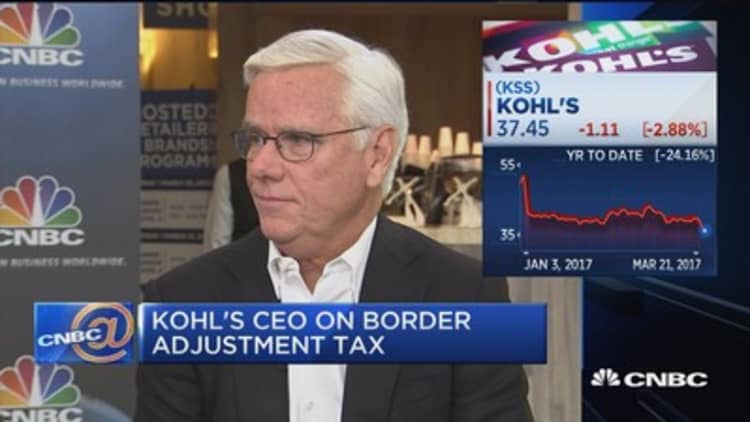
With the vast majority of its stores located outside of malls, Kohl's real estate strategy has always diverged from its mall-based competitors. Now, as chains like J.C. Penney and Macy's close hundreds of stores, the retailer is once again taking a different approach.
Instead of turning to closures as a means to boost sales productivity, CEO Kevin Mansell is looking for opportunities to trade in Kohl's big-box locations for smaller shops. His rationale? While retailers need less square footage in a world of digital commerce, consumers still crave a physical place where they can interact with the brand — and keep it on their radar.
"If you get away from all the numbers and the stories and you just think about this intellectually, at the end of the day if you're not top of mind, and you're not relevant, and you're not convenient, people are going to shop you less," Mansell told CNBC at the Shoptalk conference in Las Vegas. "It's not that complicated really."
Kohl's got a taste of that phenomenon after closing 19 stores last year. Not only did those closures eat into the company's physical revenue, they also weighed on its digital results. While Kohl's overall online sales rose 12 percent last year, they were flat in the markets where it shuttered a store, Mansell said.
The retailer's shift toward smaller stores is already underway, accounting for nearly 200 of its 1,000-plus locations. In Boston, for example, Kohl's recently took a few shops that measured between 85,000 and 100,000 square feet, and shrunk them down closer to 70,000 square feet.
In one of those instances, the landlord used the excess space to bring in another tenant. That allowed Kohl's to get its remodel paid for, and resulted in a more productive location, Mansell said.
Next year, the company will exit a two-level store in a Milwaukee mall for a one-level shop in a strip center. There, it will be surrounded by tenants who are more "complementary" to its brand, including a grocery store and Ulta. Though less than 80 of Kohl's stores are located in malls, Mansell expects that number to move lower going forward.
"It just makes more sense for us," Mansell said.
Yet even as Kohl's limited exposure to malls has made it less vulnerable to their woes, traffic has been a challenge. The chain rung up 6 percent fewer transactions during the holiday quarter, in what was its seventh straight quarterly traffic decline.
Mansell said that as more of its competitors close stores, Kohl's should be able to scoop up market share that's left on the table. Those closures should also help the company recruit more high-profile brands that are looking for distribution. Kohl's recently launched a partnership with Under Armour, which it expects will boost its total comparable sales by 0.75 to 1 percentage point this fiscal year.
Mansell's comments echo those recently made by Target CEO Brian Cornell. Like Kohl's, which has invested some $1 billion into its stores over the past three years, Target is spending $7 billion on its stores and digital operations in an effort to grab more market share.
Target on Monday gave shoppers a taste of what those investments will bring to their local stores. It plans to renovate 600 stores over the next three years.
"You can't just be in the game. You have to invest," Cornell said.


